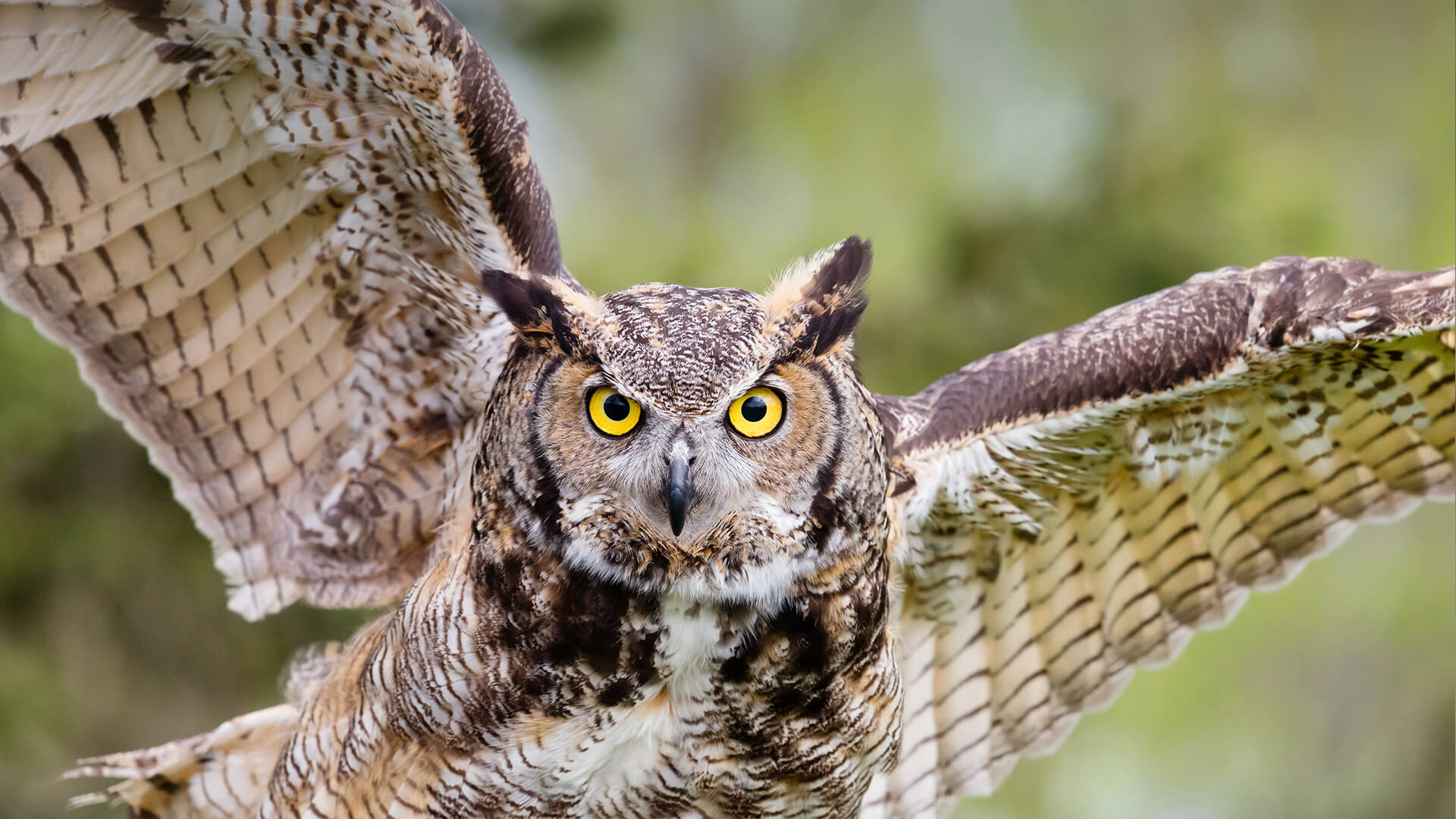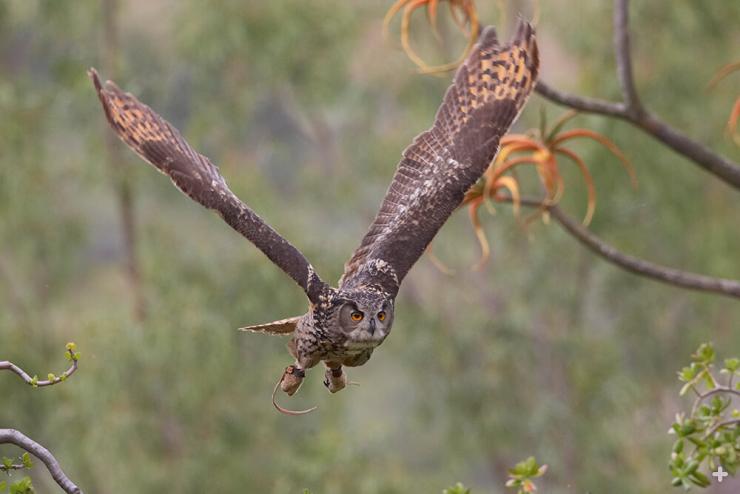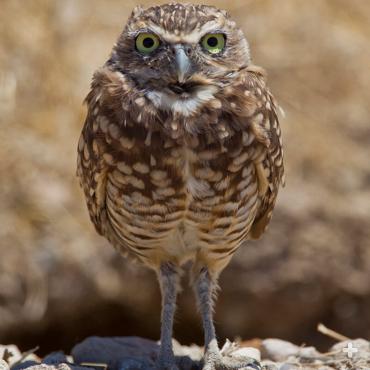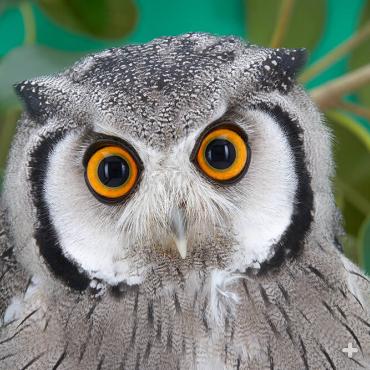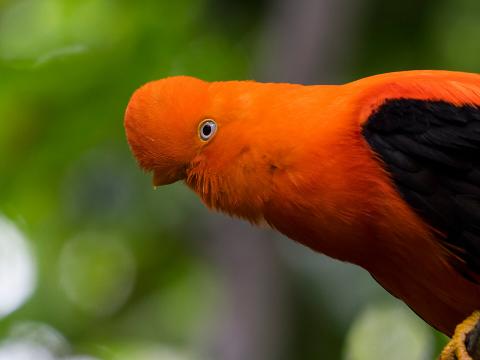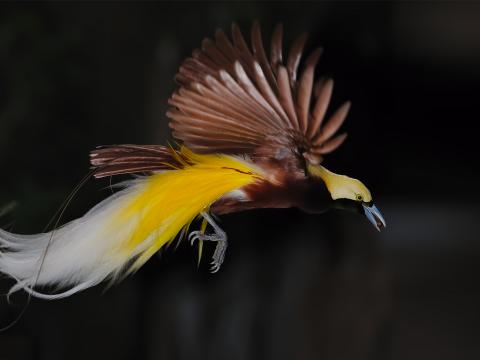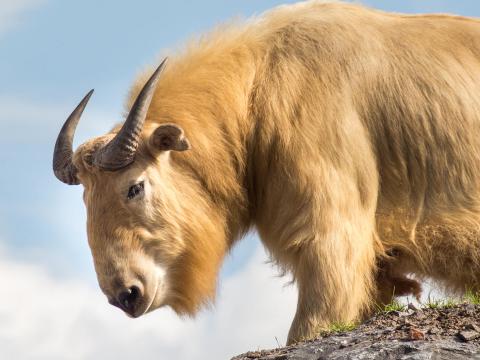Owl
- CLASS: Aves (Birds)
- ORDER: Strigiformes
- FAMILIES: Strigidae (typical owls) and Tytonidae (barn owls)
- GENERA: Typical owls 25; barn owls 2
- SPECIES: Typical owls 189; barn owls 16
ABOUT
What makes owls so mysterious to us? They have had a powerful hold on the human imagination across centuries and cultures, appearing as warnings of doom and as symbols of wisdom. Of course, we know that most are nocturnal, and their nighttime habits may make them seem scary or spooky to us. We think of them flying silently over churchyards, and their eyes seem to glow in the dark. But there’s nothing supernatural about the acute hearing and sight of owls. Far from fearing them, we should appreciate owls as competent predators that hunt mice and other rodents, helping to maintain a balance in nature.
While most of us have no problem identifying an owl—just look for that round face, sharp, hooked bill, and large eyes—it’s not as easy to distinguish between different kinds of owls. Even scientists have trouble placing some of them into the correct family group: barn owls or "typical" owls. You have to look carefully at their facial disc (for example, all barn owls have a heart-shaped facial disc, whereas typical owls have a round one), their feet, and whether or not they have ear tufts. Look for owls near your home, and see if you can identify your local owls.
Everything about an owl’s body makes it the ideal bird for night living. An owl has the best night vision of any animal, and its hearing is amazing, too.
Hearing: Did you know that an owl can hear a mouse stepping on a twig from 75 feet (23 meters) away? Every owl has two huge holes in its skull for ears, along with a facial disc that channels sound into the ear openings. Owl ears don’t look like our ears, but they are incredibly good at picking up sounds.
Vision: Wildlife that are active at night usually have large eyes that let them make use of any available light. With owls, the eyes are so big in comparison to the head that there is little room for eye muscles, meaning owls can’t move their eyes. Instead, owls move their entire head to follow the movement of prey. However, having fixed eyes gives owls better focus, with both eyes looking in the same direction. And even though it seems that owls can twist their head completely around, most owls turn their head no more than 270 degrees in either direction.
Feathers: Another important adaptation for owls is silent flight. Where other birds have stiff feathers that make a whooshing sound when they fly, owl feathers have soft edges that allow the birds to fly silently. This is important for owls, as they can swoop down on prey without being heard. The only exceptions are the fishing owls, because hunting over water does not require them to fly silently.
HABITAT AND DIET
Because there are owls living everywhere, there’s a good chance there are several in your neighborhood. Some owls prefer cold climates, while others live in deserts or rainforests. Some, like barn owls, hunt in wide-open spaces. Others, like long-eared owls, make their home in the forest. A small wingspan on a chestnut-backed owlet helps it navigate around trees in a tropical rainforest, but the longer wings on a barn owl are ideal for cruising over open fields.
In the darkness, owls don’t soar like eagles or hawks but rather fly low to the ground as they look for prey, from insects and small rodents to smaller birds and fish. Larger owls have been known to carry off young deer, weasels, and foxes. Owls compete with each other for territory and food, but different owl species can coexist by hunting at different times of the day or night. The great gray owl, the ural owl, and the tawny owl all live in the same range, but the great gray owl is a daytime hunter; it prefers voles as prey. The tawny owl also hunts voles, but only at night, and the ural owl hunts larger prey, such as squirrels.
Owls don’t have teeth, so they can’t chew their food; they rip their food apart and swallow the chunks or swallow their prey whole. They cough up or “cast” packets of bones and hair they are unable to digest. Dissecting these pellets (as many a biology student has done) reveals the owl’s diet.
FAMILY LIFE
One way to find owls is simply to listen for them calling to each other on a calm, clear night. Owls are most vocal during breeding season, making haunting hoots and scary screeches. Owls are usually solitary. To scare off intruders, the owl makes itself larger by spreading out its wings, fluffing up its feathers, and hissing.
Owls are often described as opportunists and rarely build their own nests. Instead, they look for the abandoned nests of crows, hawks, or even squirrels, or may use the crotch of a tree. Owls living in treeless areas nest on the ground or underground in existing burrows.
Courtship in owls is interesting, because they must first overcome a natural fear of one another. Male owls may bring offerings of food, dropping the item near the female, who is usually much larger, to catch her interest. Even so, it may be several hours before she loses her fear and moves closer to him. The number of eggs that are laid depends on the food supply. If prey is scarce, only two or three eggs may be laid; if food is easily available, then six or more eggs may be laid. Chicks generally hatch two days apart, with the oldest chicks getting the most food. This ensures survival of at least a few chicks if food is scarce.
Young owl chicks get the best of care from their mother for about three months. They are fed, protected from predators, and learn to fly and hunt so they can leave the nest and find territories of their own. Fathers are also often involved in rearing the chicks, including sitting on the eggs and bringing food back for the family. By about six months of age, most owl chicks look like their parents.
CONSERVATION
Whether you live in the city or the country, owls help us by controlling rodent and insect populations. But we often treat owls as enemies, and they fall victim to poison when fields are sprayed to kill weeds, insects, and rodents. We can help owls by finding other ways to control pests: for example, let owls and other predators do this job. They also need open spaces and trees if they are to survive. Each type of owl has different needs: some need forests, like the spotted owl, while the largest owl, the Eurasian eagle-owl, needs large territories and large prey.
The burrowing owl is part of our local wildlife, but it has been declining in San Diego County. San Diego Zoo Wildlife Alliance is working with various federal and local agencies to help them. We started with the ground and the California ground squirrels that dig in it. The ground was prepared by conducting “vegetation manipulation” designed to create the more open grassland habitat favored by ground squirrels and burrowing owls. Squirrels’ burrowing activity creates refuges for a variety of wildlife, including nesting sites for burrowing owls, and their foraging activities keep the vegetation low and more open.
In addition, “burrow cams” were placed in the owls’ underground nests to observe how they care for their developing chicks. We are hopeful that this will give us a richer and more detailed picture of burrowing owls’ breeding and foraging patterns and new insights into their ecology that will help define strategies that can be used regionally to restore unique and irreplaceable grassland systems that define much of the West. We are already making plans to launch a second California-wide program examining ecological and genetic factors that may be contributing to the owls’ decline.
If we set aside wilderness areas, we will help owls andother wildlife. Then laws need to be enforced so owls are not hunted or poisoned. And if we live in cities, nest boxes can be put up that make it possible for some owls to live in populated areas. We need to remember that owls play an important role, and we need to ensure a promising future for them wherever they live.
By supporting San Diego Zoo Wildlife Alliance, you are our ally in saving and protecting wildlife worldwide.

